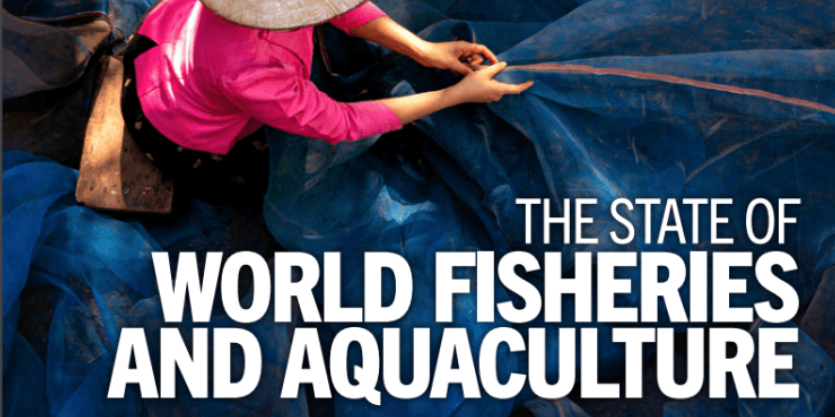State of World Fisheries and Aquaculture (SOFIA) 2024 (GS Paper 3, Economy)

Context
- According to the "State of World Fisheries and Aquaculture" (SOFIA) 2024 report by the Food and Agriculture Organization (FAO), aquaculture has surpassed capture fisheries in aquatic animal production for the first time.
- This milestone highlights significant shifts in global fisheries and aquaculture dynamics.
Overview
- The SOFIA 2024 report reveals that global fisheries and aquaculture production in 2022 surged to 223.2 million tonnes, a 4.4 percent increase from 2020.
- This production included 185.4 million tonnes of aquatic animals and 37.8 million tonnes of algae.
Aquaculture Production
- Aquaculture involves the breeding, rearing, and harvesting of fish, shellfish, algae, and other organisms in various water environments.
- Global aquaculture production reached an unprecedented 130.9 million tonnes, with 94.4 million tonnes being aquatic animals, accounting for 51 percent of total aquatic animal production.
- Currently, a few countries dominate global aquaculture production:
- China
- Indonesia
- India
- Vietnam
- Bangladesh
- The Philippines
- Republic of Korea
- Norway
- Egypt
- Chile
- These nations produce over 89.8 percent of the total aquaculture output.
Global Consumption of Aquatic Foods
- In 2021, global consumption of aquatic animal foods reached 162.5 million tonnes.
- Of the total aquatic animal production, 89 percent was used for direct human consumption, while the remainder was used for indirect or non-food purposes, such as fishmeal and fish oil production.
Fisheries and Aquaculture Sector in India
- India stands as the third-largest fish-producing country globally, accounting for 8 percent of global production and contributing about 1.09 percent to the country's Gross Value Added (GVA) and over 6.72 percent to agricultural GVA.
- India is also the fourth-largest exporter of fish and fisheries products, with a growth in exports of 26.73 percent in terms of quantity between FY 2021-22 and FY 2022-23.
In FY 2022-2023:
- Inland fisheries contributed 74.7 percent of fish production.
- Marine fisheries contributed the remaining 24.3 percent.
Challenges Faced by the Sector
- Technology Adoption: Limited access to modern technology and practices for sustainable aquaculture.
- Climate Change: Rising sea temperatures, ocean acidification, and changing weather patterns affecting fish habitats and breeding.
- Pollution: Water pollution from industrial, agricultural, and plastic waste harms aquatic life and ecosystems.
- Market Access: Limited access to international markets due to trade barriers and quality standards.
- Infrastructure: Inadequate cold storage, processing facilities, and transportation affecting fish quality and market access.
Government Initiatives
- National Marine Fisheries Action Plan (NMFAP): Measures to improve fishery resources assessment, enhance infrastructure and technology in the fisheries sector, and promote aquaculture development.
- Pradhan Mantri Matsya Sampada Yojana (PMMSY): Aimed at bringing the Blue Revolution through sustainable and responsible development of the fisheries sector from FY 2020-21 to FY 2024-25.
- Fisheries and Aquaculture Infrastructure Development Fund (FIDF): Addressing infrastructure requirements for the fisheries sector.
- 100% FDI: Allowed under the automatic route in the pisciculture and aquaculture sector in India.
- Kisan Credit Card (KCC) Scheme: Extended to fisheries and animal husbandry farmers to meet their working capital requirements.
Way Forward
- The growth of aquaculture underscores its potential to meet the rising global demand for aquatic foods.
- However, future expansion and intensification must prioritize sustainability and benefit regions and communities most in need.
- Many low-income countries in Africa and Asia are not using their full potential.
- Targeted policies, technology transfer, capacity building, and responsible investment are crucial to boost sustainable aquaculture where it is most needed, especially in Africa.
Conclusion
- The SOFIA 2024 report highlights the dynamic shifts in global fisheries and aquaculture, with aquaculture now surpassing capture fisheries in production.
- This growth presents opportunities and challenges that require coordinated efforts to ensure sustainable and equitable development in the sector.
- By addressing technological, environmental, and infrastructural challenges, countries can harness the full potential of aquaculture to support global food security and economic development.


